How and for what purpose are drainage pipes used on site
If your site is constantly or periodically flooded with groundwater, to live in this area will soon become impossible. To facilitate life, use drainage systems that can remove excess moisture from the soil to a remote distance. Plastic perforated drainage pipes are used in this case, as well as from other porous components, including concrete and ceramics.
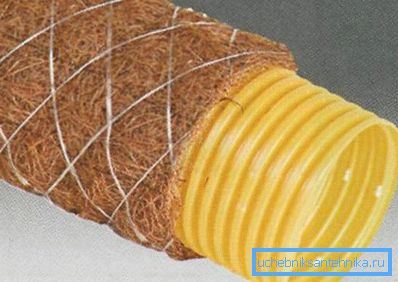
Advice: when installing a drainage system from the ground, it is necessary according to GOST to consider the drainage pipe as an element of the overall system.
Drainage system and its types
It is not difficult, but among its main elements are:
- Perforated drainage pipe.
- Fittings for connections.
- Revision wells.
- Accessories of different types to facilitate installation work.
Main types:
| Open | They are a simple version of drainage ditches and ditches. |
| Closed | In this case, the basis is a drainage corrugated pipe, most often plastic. |
| Feeding | Gravel, brick or rubble are used. |

Usually drainage systems can be found:
| Cottage and garden plots | All three types are used here:
|
| Private cottages and houses | It is used at the very beginning of construction and is an integral part of the stage when moisture is removed from the foundation. |
Types of drainage pipes
They are the main element of closed type systems. With their help, the collection and disposal of soil and surface in the drainage well.
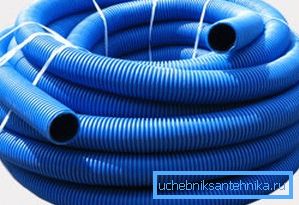
To facilitate the entry of moisture into the system in such products make special holes. Drainage of water occurs by gravity, so it is necessary to ensure their required slope during installation.
There are three types:
- ceramic;
- perforated drainage pipe made of polyvinyl chloride or HDPE, which are recognized as the best for such works;
- asbestos-cement.
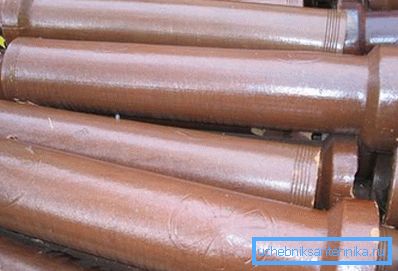
Disadvantages of asbestos-cement and ceramic pipes:
- Large mass creates additional difficulties and costs during transportation, as well as during installation, as it requires the use of special equipment.
- Installation is slow and its price is large enough. Holes or cuts must be made before they are put in place.
- Perforation requires knowledge or the use of hired labor necessary qualifications.

- Self-made perforation has low performance, as it misses a lot of silt and sand, which speeds up the clogging of the system. Because of this, it is necessary to do the flushing of pipes more often, which can also quickly become plugged, disabling the system.
- The service life of asbestos-cement products is 20 years, ceramic - 30, PVC - more than 50.

Polymer perforated drainage pipes have stiffening ribs that evenly distribute the load coming from the ground over the entire length of the product. Due to this they manage to maintain their reliability and durability.
The mass of the plastic pipeline is an order of magnitude, if not two, below other options. This makes transportation and installation easier, and you only need a regular handsaw for cutting.
Plastic drainage pipe
They can be single or double-walled, to increase the ring stiffness they make corrugated. The filter cloth is geotextiles. Due to the ease of installation and various shaped parts and fittings, as well as butt welding, such drainage systems are long and reliable.

Classification:
- raw materials can be polyethylene (primary sludge secondary) and polyvinyl chloride;
- structure - 1-2 layers;
- ring stiffness - up to SN16;
- drainage pipes can be rigid - sections of PVC with a length of 6 and 12 m, flexible - reels of 40-50 m;
- filter (coconut fiber or geofabric) and without it. This parameter is in addition to the previous ones.
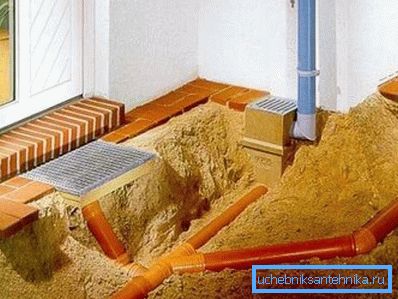
Range:
- The instruction recommends using corrugated single-layer products of low-pressure polyethylene with or without perforations for a small depth of drainage. The filter is a geofilament or coconut fiber.
- The high rigidity of double-layer pipes made of HDPE or LDPE allows them to be used at depths of up to 4 m. The filter may or may not.
- Flexible PVC corrugated pipes for drainage systems are used for depths up to 10 m. A filter made of coconut fibers or geofabric can be used without it.
- Hard corrugated drains from PND (double-layer) are used for deep moisture removal systems, up to 8 m, the filter is not installed on them.
Tip: you can use double-layer pipes for shallow soil drainage, since such products provide maximum efficiency and long service life.

Drainage device
Excess moisture in the soil affects not only the vital activity of a person, but also of plants. In addition, an inefficient abstraction from the territory of rain and melt water can cause its dilution, the destruction of the foundation of the house and other outbuildings, and the flooding of the basements.

When choosing a drainage system, it is necessary to understand which of the currently existing ones best suits your site.
If knowledge is not enough or you are in doubt, it is better to contact the specialists:
- The easiest way to drain the soil - open. In this case, along the perimeter of the site, it is necessary to dig ditches with your own hands or with the use of a technique of 500-700 mm in depth, and about half a meter in width. If the terrain implies a slope of the terrain, one can say that the task of removing surface water is solved.
Important: This option is not able to remove excess moisture from the house and often affects the overall appearance of the territory.
- An interesting option is considered to be a closed method, when trenches are dug up with a certain bias towards the latter for supplying water to the receiver.. The filler is - construction waste and branches of trees. Then they should be covered with wooden grids or lightly sprinkled with soil. The cost of it is minimal, but the system can not serve a long enough period due to the siltation of the filler.
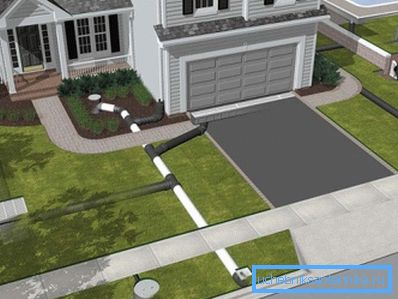
- An improved version of the previous method - installation of pipes in ditches instead of filler. The use of polymer products will allow you to forget about the repair for 50 years or more.
Conclusion
Water can be not only a friend, but also bring various inconveniences, up to the transformation of the territory of residence into unsuitable for this. In this case, the installation of a special drainage system will be optimal, where the main role is played by drainage pipes with or without geotextiles, which was discussed in this article (see also Polymer pipes: how to choose the appropriate material for arranging utilities).
Just need to remember that each of them is good in its own way, however, you should choose only the option that fits to a particular site. The video in this article will help you find additional information on this topic.